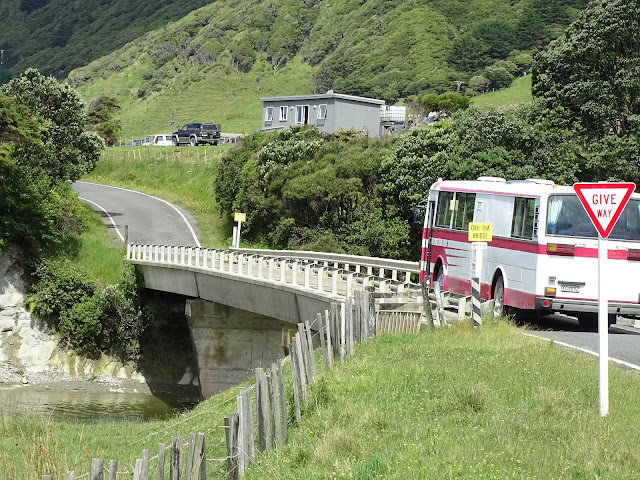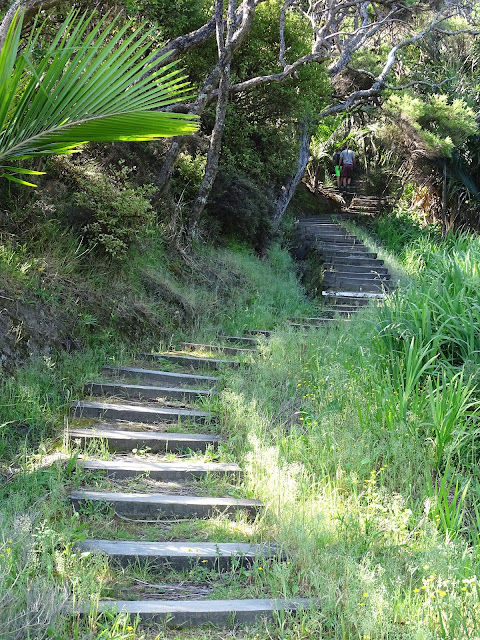The East Cape Lighthouse is the most easterly lighthouse in
New Zealand. It was originally built on East Island, just offshore from East Cape.
It was first lit in 1900, but the location proved problematic. The island was
unstable and cliffs were constantly eroding into the sea, and so a decision was
made to bring the lighthouse back to the mainland. In April 1922 the light was
extinguished on East Island and relit in December 1922 on Otiki Hill above the
East Cape. This is the easternmost point on the North Island of New Zealand and
we were keen to see it.
After leaving Te Aroroa, we travelled a few kilometres over
a no-exit, narrow, dusty, gravel road to the East Cape Campground.
It’s an unmanned camping spot—really just a large grassy
paddock—with an honesty box for payment of fees ($6 per person per night)
inside this small building.
Upon arriving, we immediately commandeered the high ground,
ensuring magnificent views of the sea. Being exposed, it was a little breezy,
but worth it for the view.
After we unhitched, Garth, Dave, Lucy and I headed off to
see the lighthouse which was only a few more kilometres further down the road. With a lot of
unfenced pastures around these parts and an abundance of horses and cattle,
it’s not surprising to find a few on the road here and there—sheep too, in one
place.
Most of the road is unsealed, one lane only, and all the way from Te Araroa there were frequent road works and one-lane bridges.
The road ran along the coastline and although signposts
indicated there might be seals about, we didn’t see any. It was a rocky
coastline with lots of huge flat rocks—perfect places for seals to be sunning
themselves, but we didn't see any today.
Eventually we arrived near the end of the road, where our
climb up to the lighthouse would begin.
Upon discovering there was a “No Dogs” restriction (hardly
surprising, but I hadn’t thought of that), Dave said he would wait at the bottom
and look after Lucy while Garth and I climbed up to the lighthouse. It was a
sunny day and too hot to leave Lucy on her own in the ute.
After walking through a paddock of horses, we arrived at the start of the climb.
800 steps! One way. And 800 back. Phew!
Half-way up the climb (or probably earlier), I questioned
the sacrificial nature of Dave’s offer. It was hard work . .
. A couple we passed coming down assured
us it was “worth it”. And as I was the one with the camera, tasked with bring
back photographic evidence, we continued.
Eventually, after several rest stops to catch our breath, we
reached the top. It was, according to the notice, a 25-minute climb, but I
didn’t have my watch on to check. I must say, it got the heart pumping, and we
were relieved when we reached the lighthouse. Thankfully, the majority of the way we
were in the shade of trees, so the sun was not a problem. Over time, as memory
fades, I will say it was a pleasant enough walk.
There were a couple of young guys up there when we arrived.
They’d started the climb at the same time as we had, but after the first bend,
we never saw them again until now. As they left to go back to the car park, we
asked them to take a message to Dave that we’d made the top, and it would take
a while for us to get back to him.
We rested up for a while, reading about the lighthouse’s
history.
Although it was originally manned by three men, since 1985 it’s been
fully automated and is now controlled remoted by Maritime NZ in Wellington.
From this height, we could see another beautiful bay in the
distance . . .
. . . and East Island a little offshore.
I expected it to be easier going back down, but my legs are
short, and it’s a stretch from step to step. Yes, surely it was not as
difficult as climbing up, but harder on the legs.
By the time we got “home” my
legs were shaking! I am obviously not climbing fit . . . but happy that I made it
to the top. The next day, my calf muscles were aching—complaining about
the unaccustomed abuse.
Sadly, there was no internet access at East Cape—our
Netspeed modem uses Vodafone—so we only stayed the one night. The next morning
it was back to Te Araroa where we knew we could get good internet, and we
parked on the side of the road for a few hours to catch up on
some work while Garth and Helen headed south.
By mid-afternoon, we decided
we would travel on to Tokomaru Bay rather than stay the night in the Te Araroa Campground. We thought we’d get to stay there at least two nights, and
both Dave and I prefer to spend longer than one night in each place. One night only is never enough time to experience the surroundings, meet
and talk to people, spend time keeping our work up to date, and relax. After a
week of one-night stays, we can get a bit tired (and cranky).
If you cannot see the "Post a Comment" box below, click here to talk to me!
























No comments:
Post a Comment
Comments are very much appreciated. Thanks for taking the time to do so.